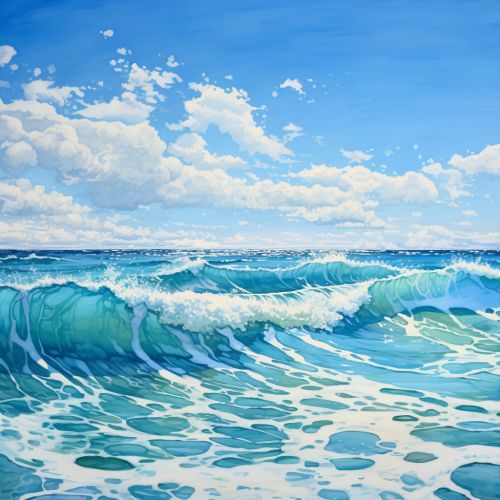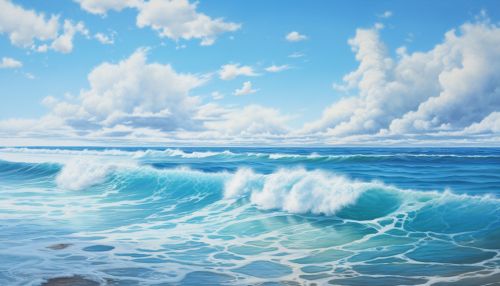Ocean waves
Introduction
Ocean waves are the undulations of the sea surface that are caused by the transfer of wind energy into water. They are a major part of the Earth's hydrosphere, and play a crucial role in the global climate system. The study of ocean waves is a branch of physical oceanography.


Formation of Ocean Waves
Ocean waves are primarily formed by the frictional drag of wind over the water surface. This process, known as wind wave generation, involves the transfer of energy from the moving air to the water. The size and energy of the waves depend on the wind speed, its duration, and the fetch, which is the distance over which the wind blows.
Types of Ocean Waves
Ocean waves can be categorized into several types based on their characteristics and the forces that generate them.
Wind Waves
Wind waves are the most common type of ocean waves. They are generated by the local wind and are also known as sea waves or surface waves. The size of wind waves depends on the wind speed, its duration, and the fetch.
Swell Waves
Swell waves are long, smooth waves that have traveled out of their generating area. They are formed by the dispersion of wind waves, which causes them to sort out into groups of similar speeds and wavelengths.
Tsunami Waves
Tsunami waves are caused by undersea earthquakes, volcanic eruptions, or landslides. They can travel across entire ocean basins with little energy loss.
Tidal Waves
Tidal waves are caused by the gravitational pull of the moon and the sun. Despite their name, they are not related to tsunamis.
Wave Characteristics
Ocean waves have several key characteristics that define their physical properties.
Wave Height
Wave height is the vertical distance between the crest (the highest point of the wave) and the trough (the lowest point). It is a measure of the energy in a wave.
Wave Length
Wave length is the horizontal distance between two successive crests or troughs.
Wave Period
Wave period is the time it takes for two successive wave crests to pass a fixed point.
Wave Speed
Wave speed, or celerity, is the speed at which a wave crest moves. It is determined by the wave length and the wave period.
Wave Frequency
Wave frequency is the number of wave crests passing a fixed point per unit of time. It is the inverse of the wave period.
Wave Dynamics
The motion of ocean waves is governed by the principles of fluid dynamics. The wave speed, direction, and shape are influenced by the water depth, the sea floor topography, and the presence of currents and tides.
Wave Energy and Power
Ocean waves carry energy that can be harnessed for human use. Wave power is a form of renewable energy that uses the motion of the waves to generate electricity.
Impact on Coastal Areas
Ocean waves shape the coastline through the processes of erosion, transport, and deposition. They also have a significant impact on human activities, such as navigation, fishing, and coastal development.
